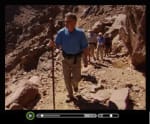Mount Sinai
Mount Sinai – The Traditional Locations
The traditional Mount Sinai (also known as Mount Musa) lies at the southern end of the Sinai Peninsula, rising to 7,497 feet. Nearby are Mount Catherine, the tallest mountain in the region at 8,625 feet, and Mount Serbal, with an elevation of 6,750 feet. A popular tourist and pilgrimage spot because of its alleged relation to Biblical history, Mount Sinai in “recent” tradition has been regarded as a mountain at the southern tip of the Sinai Peninsula based on beliefs established long after the Old Testament was written. A monastery was originally established in the 4th century AD at Mt. Serbal, then moved in the 6th century to nearby Mt. Catherine based on the writings of Josephus Flavius claiming that Mt. Sinai was the tallest mountain in the area. The adjacent Mt. Moses, the current popular site and the location favored in Bedouin tradition and the Quran, was supposedly chosen by Helena of Constantinople, mother of Emperor Constantine the Great, in about 330 AD. The pilgrim Egeria (also called Aetheria), who travelled the Holy Land in about 381-384 AD, also believed Mt. Musa (Mount Moses) was Mount Sinai.
Mount Sinai – The Location Controversy
Regardless of this varied tradition regarding the location of Mount Sinai, there is no archaeological or definitive ancient textual evidence for any of these locations. As such, the precise location of Mt. Sinai is highly disputed. Recently, scholars have argued for various locations of the true Mount Sinai, with the two areas of northeast Sinai Peninsula and northwest Saudi Arabia being the most popular alternative locations. The reasoning for Mt. Sinai being located in northwest Saudi Arabia comes from the Apostle Paul’s writing in Galatians 4:25, which says, “Now Hagar stands for Mount Sinai in Arabia” and the fact that there are volcanic mountains to explain the fire and glory of God in Saudi Arabia, but not in the Sinai Peninsula. The most obvious problem with this is the mistaken association of the 1st century AD Roman province of Arabia Petraea, which encompassed all of the Sinai Peninsula in addition to Jordan, southern Syria, the Negev, and a small part of northwestern Saudi Arabia. Placing the mountain in northeast Sinai is related to the references to Mt. Seir and Edom in northeast Sinai and southwest Israel associated with Mt. Sinai, and the travel time from the mountain to Kadesh Barnea, located in northeast Sinai. Debates over the rate of travel for the Israelites during the wilderness wandering have made the issue complicated.
Mount Sinai – Moses and the Ten Commandments
Mount Sinai was the site where the Israelites camped while Moses went up the mountain to receive the Ten Commandments from God. Eventually, the entire Law of Moses was given, forming a detailed law code for the nation of Israel. Interestingly, many components of the Mosaic Law code are similar to those of the Late Bronze Age found in other ancient Near Eastern societies, and distinctly different than the style of law codes and customs found in the earlier Middle Bronze Age into which the Patriarchal period fits, and later Iron Age into which the Israelite Monarchy period fits.
Mount Sinai – Codex Sinaiticus
Probably the most significant discovery in this southern Mount Sinai area came in the 19th century at the Monastery of Saint Catherine. In the mid-1800’s, a German Biblical scholar named Constantin von Tischendorf visited the monastery and noticed some ancient manuscripts of the Septuagint, the Greek translation of the Old Testament, some of which he was allowed to take back to Germany. On one of his return trips the monks showed him Codex Sinaiticus, a 4th century complete Bible written in Uncial script Greek, containing both the entire Septuagint and the entire Greek New Testament. Uncial script uses all capital letters and no spaces between words, but fell out of use around the 9th century. Sinaiticus is especially significant because it contains the oldest entire Greek New Testament. The story goes that on Tischendorf’s first visit to the monastery, he found some ancient Greek manuscripts of the Septuagint in a rubbish bin, waiting to be burned. Later, on a return trip, he was allowed access to Codex Sinaiticus, which had been preserved in the monastery library and was in excellent condition. He convinced the monks to send the codex to Saint Petersburg, where it remained until 1933 when the Soviets sold it to the British Museum for 100,000 Pounds. Most of the text now resides in the British Library, where it is on display and also a digital version of each page has been made available for all to access. The discovery of this and other ancient Greek New Testament manuscripts spurred on the research of a discipline called New Testament textual criticism, which seeks to discover the exact words of the original manuscripts, by comparing the differences throughout manuscripts in word order, spelling, grammar, and added or removed words and phrases. This discipline has so far revealed that our current Greek New Testament is more accurate and reliable than any other ancient document, and fragments have been discovered that date to within 100 years of the original composition—unprecedented finds in comparison to other ancient texts.
Compliments of Titus and our friends at Drive Thru History. Copyright 2010 – All rights reserved in the original.
What is your response?

